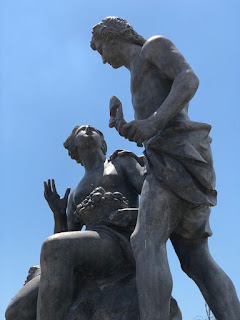The Palace of Queluz
An Austrian friend is a specialist of castles in Europe. He likes to travel with cruise, going to different countries. He had only one day for Lisbon in one of his cruise trips. It is the first time that he landed his feet at Lisbon. He did not choose any other key sightseeing points but went straight to the Palace of Queluz and was amazed with its beauty. My trip partner took his recommendation. It's very worthwhile. The palace is beautiful inside and so as the exterior including the garden. Restoration and enhancement efforts made the Palace of Queluz one of the most beautiful palaces in Portugal.
The Palace was conceived as a summer retreat for Dom Pedro of Braganza who later became husband and then king consort to his own niece Queen Maria I. The construction of the palace began in 1747. After the destruction of Ajuda Palace in 1794 (by fire), Queluz Palace became the official residence of the royal family until they fled to Brazil in 1807 following the French invasion. In 1908, it became the property of the state.
The visit started with the interior first. French artisans were employed to decorate the rooms, walls and ceiling painted to depict allegorical and historical scenes. Polished red bricks are often used for the floors to create a rustic look and serve to cool in hot weather. Another common feature: giant magnificent chandeliers are hung in big and small rooms.


The chapel may be the only important room without a chandelier.
A small section is dedicated to hot chocolate. At time, the court liked the new fashion of drink very much. Paintings of the noble / royal family featuring the cup of chocolate.
The saddest part of the visit is the Quixote Room. Pedro IV, the first Emperor of Brazil and the first Portuguese constitutional monarch, died (tuberculosis) here very young, immediately after the liberal victory. He was borne in the Don Quixote Room 36 years ago and survived his last breadth here.

Once stepped out of the palace is a lush green garden and many statues (many are from mythology) dotting the area, including those decorating the buildings.
 A number of lead statues are work from a British artist John Cheere. One is Vertumnus and Pomona. Vertumnus is the god of seasons, change, plant growth, gardens and fruit trees. He could change his form. He tricked Pomona into talking to him by disguising himself as an old woman and gaining entry to her Orchard.
A number of lead statues are work from a British artist John Cheere. One is Vertumnus and Pomona. Vertumnus is the god of seasons, change, plant growth, gardens and fruit trees. He could change his form. He tricked Pomona into talking to him by disguising himself as an old woman and gaining entry to her Orchard.
Others include the abduction of Persephone, Venus and Adonis, Aeneas flees burning Troy carrying his father Anchises and his son, etc.
The visit was very enjoyable as the sun was shinning, the place gorgeous and only a handful of tourists.
The saddest part of the visit is the Quixote Room. Pedro IV, the first Emperor of Brazil and the first Portuguese constitutional monarch, died (tuberculosis) here very young, immediately after the liberal victory. He was borne in the Don Quixote Room 36 years ago and survived his last breadth here.

Once stepped out of the palace is a lush green garden and many statues (many are from mythology) dotting the area, including those decorating the buildings.
 A number of lead statues are work from a British artist John Cheere. One is Vertumnus and Pomona. Vertumnus is the god of seasons, change, plant growth, gardens and fruit trees. He could change his form. He tricked Pomona into talking to him by disguising himself as an old woman and gaining entry to her Orchard.
A number of lead statues are work from a British artist John Cheere. One is Vertumnus and Pomona. Vertumnus is the god of seasons, change, plant growth, gardens and fruit trees. He could change his form. He tricked Pomona into talking to him by disguising himself as an old woman and gaining entry to her Orchard.Others include the abduction of Persephone, Venus and Adonis, Aeneas flees burning Troy carrying his father Anchises and his son, etc.





















Comments